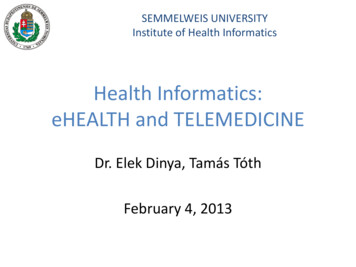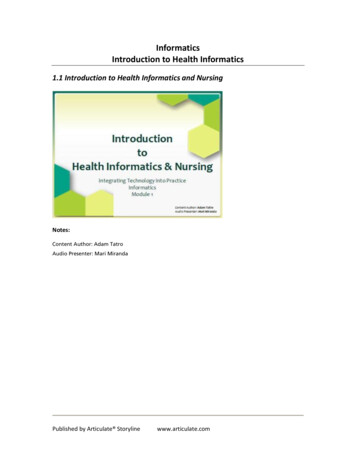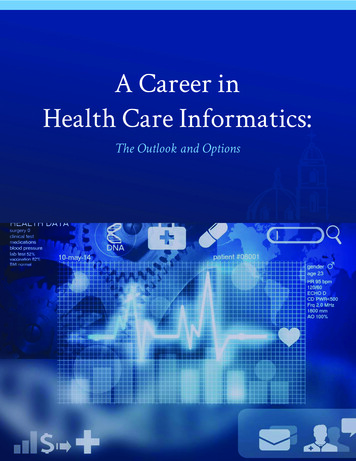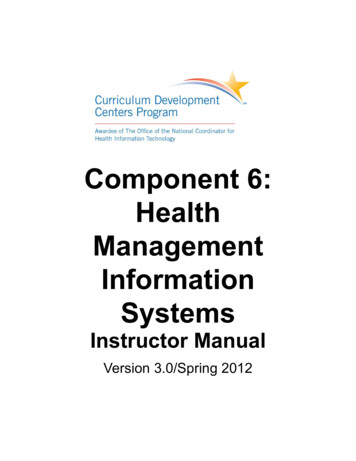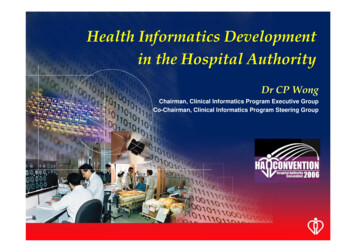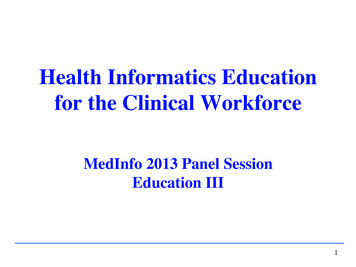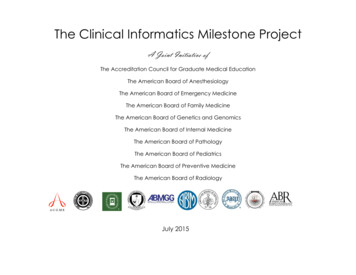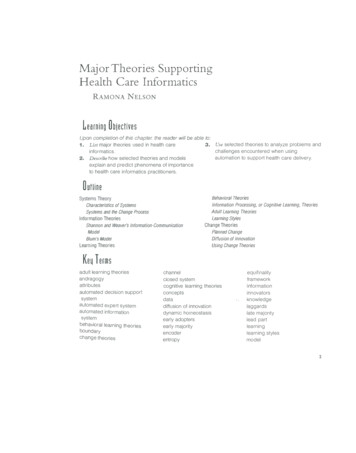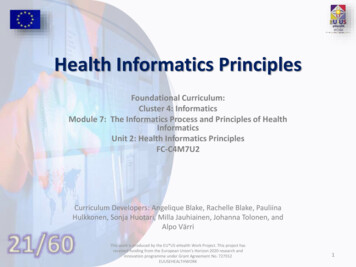
Transcription
Health Informatics PrinciplesFoundational Curriculum:Cluster 4: InformaticsModule 7: The Informatics Process and Principles of HealthInformaticsUnit 2: Health Informatics PrinciplesFC-C4M7U2Curriculum Developers: Angelique Blake, Rachelle Blake, PauliinaHulkkonen, Sonja Huotari, Milla Jauhiainen, Johanna Tolonen, andAlpo Vӓrri21/60This work is produced by the EU*US eHealth Work Project. This project hasreceived funding from the European Union’s Horizon 2020 research andinnovation programme under Grant Agreement No. 727552EUUSEHEALTHWORK1
Unit Objectives Describe the evolution of informatics Explain the benefits and challenges ofinformatics Differentiate between information technologyand informatics Identify the three dimensions of healthinformatics State the main principles of health informaticsin each dimensionFC-C4M7U2This work is produced by the EU*US eHealth Work Project. This project hasreceived funding from the European Union’s Horizon 2020 research andinnovation programme under Grant Agreement No. 727552EUUSEHEALTHWORK2
The Evolution of Health Informatics(1940s-1950s) In 1940, the first moderncomputer was built called theENIAC. It was 24.5 metric tonnes(27 tons) in volume and took up63 m2 (680 sq. ft.) of space In 1950 health informatics beganto take off with the rise ofcomputers and microchips. Theearliest use was in dental projectsduring late 50s in the US. Worldwide use of computertechnology in healthcare began inthe early 1950s with the rise ofmainframe computersFC-C4M7U2This work is produced by the EU*US eHealth Work Project. This project hasreceived funding from the European Union’s Horizon 2020 research andinnovation programme under Grant Agreement No. 727552EUUSEHEALTHWORK3
The Evolution of Health Informatics(1960s) Specialized university departments and informaticstraining programs began during the 1960s in France,Germany, Belgium and The Netherlands The International Medical Informatics Association(IMIA) was established in 1967 as a technicalcommittee of the International Federation forInformation Processing (IFIP).– IMIA is an independent organization that plays a role inpromoting and furthering the application of informationscience in modern society, particularly in the fields ofhealthcare, bioscience and medicine One of today’s major healthcare IT organizationswas originally founded in 1961 by industrialengineers whose focus was to improve theefficiency of healthcare. The organization’s originalacronym was HMSS, which stood for the HospitalManagement Systems Society– There were approximately 45 members at the firstnational convention of HMSSFC-C4M7U2This work is produced by the EU*US eHealth Work Project. This project hasreceived funding from the European Union’s Horizon 2020 research andinnovation programme under Grant Agreement No. 727552EUUSEHEALTHWORK4
The Evolution of Health Informatics(1970s) In the 1970’s computers were beginning to beused more in hospitals – The focus there was primarily financial (billing,tracking charges, data processing, etc.)– Computers were not routinely used in the clinicalsetting. Most of the people working withcomputers were computer specialistsMEDLINE (the online resource for accessing biomedicalliterature) began at the National Library of Medicine inthe 70sMedical informatics research units began to appearduring the 1970s in Poland and in the USAlso in the 1970s, academic physicians were applyingscience to physicians’ thinking by teaching medicalproblem solving and the foundation of clinical decisionsupportFC-C4M7U2This work is produced by the EU*US eHealth Work Project. This project hasreceived funding from the European Union’s Horizon 2020 research andinnovation programme under Grant Agreement No. 727552EUUSEHEALTHWORK5
The Evolution of Health Informatics(1980s) Remember HMSS? During the 1980sthe word “information” was added tothe acronym, and the “hospital” termwas changed to “health” to be moreinclusive; the acronym then becameHiMSS (Health Information &Management Systems Society), as it isknown today– Today’s HIMSS annual conventionsattract a global audience of more than45,000 attendees Since the 1980s, the development of highquality health informatics research, educationand infrastructure has been a goal of the U.S.and the European UnionFC-C4M7U2This work is produced by the EU*US eHealth Work Project. This project hasreceived funding from the European Union’s Horizon 2020 research andinnovation programme under Grant Agreement No. 727552EUUSEHEALTHWORK6
The Evolution of Health Informatics(1980s Cont’d) In the 1980s, the informatics communitywas also beginning to organize more intoprofessional organizations IMIA became an independent organizationin 1987 and was established under Swiss lawin 1989 The American Medical InformaticsAssociation (AMIA) was formed in 1988 The National Library of Medicine (NLM) (US)began to fund training programs ininformatics that are today a major fundingsource for training research informaticians(also known as an informaticist, aninformatician is an interdisciplinaryprofessional practicing the science ofinformatics) In addition, the 1980s broughtspecializations within informatics, such asNursing InformaticsFC-C4M7U2This work is produced by the EU*US eHealth Work Project. This project hasreceived funding from the European Union’s Horizon 2020 research andinnovation programme under Grant Agreement No. 727552EUUSEHEALTHWORK7
The Evolution of Health Informatics(1990s) Beginning in the 1990s and continuing tothe present, we have seen much moregeneral computer use The 1990s saw a need for increasedpractice efficiency, and younger physiciansmore likely to be receptive totechnological improvements that canimprove efficiency There was a growing trend for patientempowerment in the 90s. The shift wasalso fueled by technology changes, such asincreasing availability of the Internet forhealthcare information. Populations werebecoming more and more comfortablewith accessing that information throughtechnologyFC-C4M7U2This work is produced by the EU*US eHealth Work Project. This project hasreceived funding from the European Union’s Horizon 2020 research andinnovation programme under Grant Agreement No. 727552EUUSEHEALTHWORK8
The Evolution of Health Informatics(1990s-2000s) The Data Protection Directive (officiallyDirective 95/46/EC on the protection ofindividuals with regard to the processing ofpersonal data and on the free movement ofsuch data), which regulates the processing ofpersonal data within the European Union, wasadopted in 1995 In the US, HIPAA health data security legislationwas passed in 1996 In the 2000s Personal Health Records, that iselectronic records of patient informationcontrolled by the patients themselves, havebegun to be developed One of the key foci in healthcare continuing intothe 2000s was the concern with quality of care.This concern has continued to the presentFC-C4M7U2This work is produced by the EU*US eHealth Work Project. This project hasreceived funding from the European Union’s Horizon 2020 research andinnovation programme under Grant Agreement No. 727552EUUSEHEALTHWORK9
The Evolution of Health Informatics(2000s) The use of clinical guidelines andstandardized protocols of careincreased during this period. This is amajor reason for an increased use ofinformation technology The 2000s saw an increase in usingtechnology for remote monitoring ofpatients in their homes, or what hasbeen called telehealth Whereas telemedicine has tended tofocus on treating acutely sick patients,telehealth can include monitoringpatients with chronic conditions, oreven working with patients throughcomputer access, to keep themhealthyFC-C4M7U2This work is produced by the EU*US eHealth Work Project. This project hasreceived funding from the European Union’s Horizon 2020 research andinnovation programme under Grant Agreement No. 727552EUUSEHEALTHWORK10
The Evolution of Health Informatics(2010s) The 2010s brought the implementation ofmeaningful use of Electronic HealthRecords for Hospitals and Physicians in theUnited States, within their Medicare andMedical reimbursement programs. This ledto gradual implementation and use ofEMR/EHRs by a majority of healthcareproviders and organizations nationwideover the first half of the decade The 2010s also saw widespread use ofsocial media, smart phones, handheldtechnologies and other consumerapplications for healthcare and telehealthpurposes The General Data Protection Regulation,adopted in April 2016, supersedes the DataProtection Directive of 1995 and isenforceable starting on 25 May 2018FC-C4M7U2This work is produced by the EU*US eHealth Work Project. This project hasreceived funding from the European Union’s Horizon 2020 research andinnovation programme under Grant Agreement No. 727552EUUSEHEALTHWORK11
Technology Evolution in HealthInformaticsAnalogue era (1950’s to 1980’s): Telephone calls (or letters and physical visits) from patients Information was stored by typing or handwriting to a diary Chronological order of visits, patient information transcribedor mapped by a secretary stored in archivesDigital era (1990’s to 2000’s): Data and information was written on a computer instead of atypewriter Internet could be used for searching information New ways of collecting data: images, imaging, sensors Data could be faxed or scanned Data is stored electronicallyCyber era (2010’s to present): Data is stored online for other doctors AND the patient to see Databases for symptoms, statistics and recommendations Active participation from other clinicians and the patient,other than just by calling to the doctor Social media, smart phones, internet applications and cloudstorage are used for health information, education,communication and exchangeFigure: available (cited 18.10.2017): o-slowlyFC-C4M7U2This work is produced by the EU*US eHealth Work Project. This project hasreceived funding from the European Union’s Horizon 2020 research andinnovation programme under Grant Agreement No. 727552EUUSEHEALTHWORK12
The Benefits of Health Informatics Information is easily available in a digital format for healthcareprofessionals, the patient and possibly by family members as well(with proper authentication and credentials) Modern statistics and datasets, aligned with best practices andstandards of care, are designed help clinicians quickly assess andmake recommendations regarding symptoms, diagnoses andtreatments. Flags and alerts are built in for better care protocolsand minimize drug interactions, allergies, etc. Single-sign-on (SSO) and biometrics can eliminate the need formultiple passwords, logons, etc. Robust automatic and electronic systems decrease the timerequired for scheduling, storing data and sending information Younger, technology saavy healthcare staff are often very opento using digital skills in the workplaceFC-C4M7U2This work is produced by the EU*US eHealth Work Project. This project hasreceived funding from the European Union’s Horizon 2020 research andinnovation programme under Grant Agreement No. 727552EUUSEHEALTHWORK13
The Challenges of Health Informatics Information may need to be made available in different formats (paper,media, etc.) depending on patient preference and needs Clinical decision support engines and databases work best when then arestandardized, making customization difficult and sometimes discouraged.Also, alerts may be over-sensitive. This may lead to decrease of use bysome clinicians Cybersecurity is crucial when handling personal healthcare data,protection is dependent on the systems and devices, but also theprofessional’s actions Requirements for hardware and software increase, when the systems getmore complex More education is required for the workforce to handle all the technologyused in the healthcare settingsFC-C4M7U2This work is produced by the EU*US eHealth Work Project. This project hasreceived funding from the European Union’s Horizon 2020 research andinnovation programme under Grant Agreement No. 727552EUUSEHEALTHWORK14
Information Technology versusInformatics It is important to understand the difference between informationtechnology and informatics– The concept of health IT includes the use of technology in the healthcare field,but health informatics is not synonymous with health IT. Instead, informatics is“the science, the how and why, behind health IT,” according to the US Centersfor Disease Control and Prevention. Information technology concentrates on the development, designand implementation of systems and technology tools in workingwith information Focus is on the Development of systems and technology Informatics is concerned with the development, design andusability of information systems and technology tools to enableadoption, application or transformation of a process, for example,healthcare or biotechnology Focus is on the Process of integrating information and systemsFC-C4M7U2This work is produced by the EU*US eHealth Work Project. This project hasreceived funding from the European Union’s Horizon 2020 research andinnovation programme under Grant Agreement No. 727552EUUSEHEALTHWORK15
The Dimensions of HealthInformatics Health informatics incorporates acombination of knowledge, skills andabilities obtained from thedimensions of ICT, HIM and HIT The dimensions blend informationand technology, health andmanagement sciences Basically, Health informatics ismaking computers and technologyaccessible and usable for cliniciansand all other end usersFC-C4M7U2Information andCommunicationsTechnology (ICT)HealthInformationManagement(HIM)This work is produced by the EU*US eHealth Work Project. This project hasreceived funding from the European Union’s Horizon 2020 research andinnovation programme under Grant Agreement No. IT)16
The Principles of Health InformaticsEach dimension has several key principles that are important tothe practice of health informaticsInformation andCommunicationsTechnology (ICT)ICT Principles: Facilitate appropriate consumer use of health information and communicationtechnologiesIntegrate data quality into the identification, use and management of information systemsAddress information, business, and technical requirements to meet the full range ofstakeholders’ information needsContribute to the selection and utilization of appropriate information technologies to meetbusiness requirementsApply appropriate health informatics standards and models to enable systeminteroperabilityApply knowledge of health data, information and workflow models to informationtechnology solutionsRelate information technology best practices (quality management systems, testing,service level agreements, business continuity, incident management) throughout thesystem life cycleFollow best practices and implement solutions required to maintain the security of data,systems, devices and networksFC-C4M7U2This work is produced by the EU*US eHealth Work Project. This project hasreceived funding from the European Union’s Horizon 2020 research andinnovation programme under Grant Agreement No. 727552EUUSEHEALTHWORK17
The Principles of Health InformaticsHIM Principles: Demonstrate understanding of the need to balance the privacy of personalhealth information with improved care delivery and health systemmanagementPromote an information culture by facilitating appropriate uses ofinformation and knowledgeFacilitate individual, team, interdisciplinary and organizational learning anddevelopment through the use of appropriate technologies, communicationchannels and organizational skillsUse quality improvement and process engineering to facilitate business andclinical transformationContribute to ongoing evaluation of the functionality of systems so that theycan evolve to support best practice in clinical careApply principles of change management in the implementation of newprocesses or systemsDemonstrate knowledge of indicators and metrics for healthcare deliveryand systems managementAssess and mitigate safety, privacy and other risks associated with healthinformation and systems throughout the system life cycleFC-C4M7U2This work is produced by the EU*US eHealth Work Project. This project hasreceived funding from the European Union’s Horizon 2020 research andinnovation programme under Grant Agreement No. IM)18
The Principles of Health InformaticsHIT Principles: Apply knowledge of basic clinical and biomedical concepts, clinical careprocesses, technologies and workflowDemonstrate knowledge of analysis, design, development andimplementation of health information systems and applicationsDemonstrate knowledge of commonly used formats, structures and methodsfor recording and communicating clinical data and how these areincorporated into system and application useFoster the adoption and use of health information systems in clinical settingsDemonstrate an understanding of architectural relationships between keyhealth information technology componentsFacilitate clinicians’ use of electronic decision support tools in accessingevidence to support practiceAddress the challenges related to the adoption and realization of the clinicalvalue of information systems and technology in the health sectorPromote the safe and appropriate use of health information technologies toensure patient safetyFC-C4M7U2This work is produced by the EU*US eHealth Work Project. This project hasreceived funding from the European Union’s Horizon 2020 research andinnovation programme under Grant Agreement No. 727552EUUSEHEALTHWORKHealthInformationTechnology (HIT)19
Unit Review Checklist Described the evolution of informatics(FFB02) Explained the benefits and challenges ofinformatics (FFB01) Differentiated between informationtechnology and informatics (JB05) Identified the three dimensions of healthinformatics Stated the main principles of healthinformatics in each dimensionFC-C4M7U2This work is produced by the EU*US eHealth Work Project. This projecthas received funding from the European Union’s Horizon 2020research and innovation programme under Grant Agreement No.727552 EUUSEHEALTHWORK20
Unit 21 Review Exercise/ActivityOn the timeline below, list a major event in the evolution ofhealth informatics for each of the decades This work is produced by the EU*US eHealth Work Project. This project hasreceived funding from the European Union’s Horizon 2020 research andinnovation programme under Grant Agreement No. 727552EUUSEHEALTHWORK21
Unit Exam1. True or False:AMIA was started in 1967TF2. True or False:The earliest use of computers in health informatics was indental projects during late 50s in the USTF3. True or False:There were over 40 members at the first HMSS convention inthe 1960sTF4. True or False:The use of clinical guidelines and standardized protocols ofcare increased significantly during the 1970sTFFC-C4M7U2This work is produced by the EU*US eHealth Work Project. This project hasreceived funding from the European Union’s Horizon 2020 research andinnovation programme under Grant Agreement No. 727552EUUSEHEALTHWORK22
Unit Exam (cont’d)5. Which of the following is a challenge of healthinformatics?a. Modern statistics and datasets used to comparesymptoms, diagnoses and treatmentsb. Information is easily available in a digital format forhealthcare professionals, the patient and possibly byfamily members as well (with proper authenticationand credentials)c. Protection and security of data and information isnot only dependent on the systems and devices, butalso on the professional’s actionsd. Electronic systems decrease the time required forscheduling, storing data and sending informationFC-C4M7U2This work is produced by the EU*US eHealth Work Project. This project hasreceived funding from the European Union’s Horizon 2020 research andinnovation programme under Grant Agreement No. 727552EUUSEHEALTHWORK23
Unit Exam (cont’d)6. Which of the following is an HIM principle ofhealth informatics?a. Contribute to the selection and utilization ofappropriate information technologies to meetbusiness requirementsb. Contribute to ongoing evaluation of the functionalityof systems so that they can evolve to support bestpractice in clinical carec. Demonstrate knowledge of analysis, design,development and implementation of healthinformation systems and applicationsd. Demonstrate an understanding of architecturalrelationships between key health informationtechnology componentsFC-C4M7U2This work is produced by the EU*US eHealth Work Project. This project hasreceived funding from the European Union’s Horizon 2020 research andinnovation programme under Grant Agreement No. 727552EUUSEHEALTHWORK24
The Evolution of Health Informatics (1940s-1950s) In 1940, the first modern computer was built called the ENIAC. It was 24.5 metric tonnes (27 tons) in volume and took up 63 m2 (680 sq. ft.) of space In 1950 health informatics began to take off with the rise of computer
